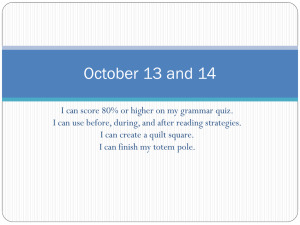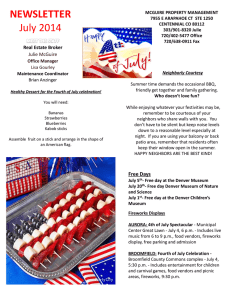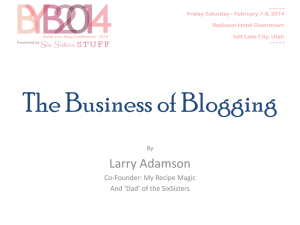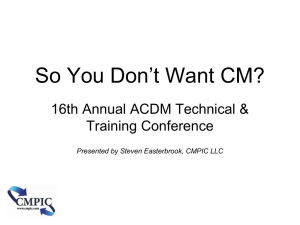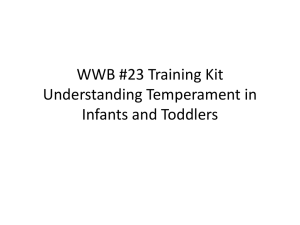Age Appropriate Expectations = Age Appropriate Behaviors
advertisement
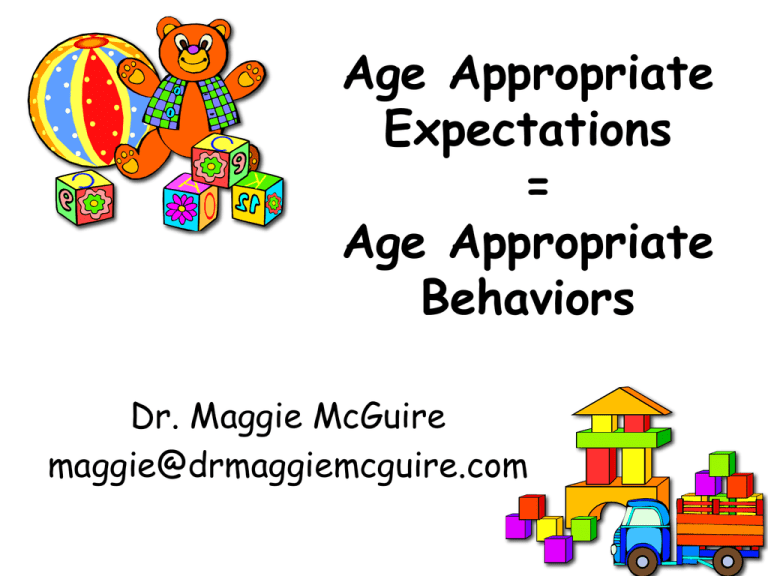
Age Appropriate Expectations = Age Appropriate Behaviors Dr. Maggie McGuire maggie@drmaggiemcguire.com What one behavior makes you… • Crazy © Dr. Maggie McGuire LLC • Is the behavior appropriate to the age of the child? • Are your expectations appropriate to the age of the child? OR © Dr. Maggie McGuire LLC Developmentally Appropriate Behavior/Expectations 0-17 months Expresses emotions: Pleasure, sadness, fear/anxiety (stranger anxiety & separation anxiety) Anger/negative feelings Shows anger focused on people or objects Shows pleasure in mastery/new accomplishments Shows affection for familiar people, asserts self (strong sense of self). Expects needs to be addressed IMMEDATELY! No concept of other’s needs. They are the center of their world. Limited thought processes No concept of time. No control of emotions (Flooding) © Dr. Maggie McGuire LLC Developmentally Appropriate Behavior/Expectations 18 months-3yrs Frequently displays aggressive feelings/behavior Exhibits mood shifts (stubborn/compliant) Verbalizes feelings more often Shows increased fearfulness (of dark, monsters, etc.) Shows concern for others Difficulty sharing/taking turns. Expects needs to be addressed IMMEDATELY! No concept of other’s needs. They are the center of their world. Limited thought processes No concept of time. No control of emotions (flooding) © Dr. Maggie McGuire LLC Developmentally Appropriate Behavior/Expectations 3-5 years Begins to understand turn taking/sharing Usually needs help to resolve conflicts Outbursts of anger with justification (“he hit me first”) Still needs help controlling feelings Begins cooperative play Forms small groups that may exclude a peer Shows less physical aggression – moves to verbal insults or threats, may lie rather than admit breaking rules Little concept of other’s needs. They are the center of their world. Limited thought processes Little concept of time. Little control of emotions (flooding) © Dr. Maggie McGuire LLC Common Behavioral Challenges • • • • • Testing Limits Physical Aggression Biting Temper Tantrums Bullying © Dr. Maggie McGuire LLC Most Important WHY are they doing it? • Ask yourself – Is it developmentally appropriate to their age? – Or is it because they can? © Dr. Maggie McGuire LLC In your groups Using the card that your group has been given, 1 Decide whether or not you would see this behavior in the three different age groups. 2 What would it look like? 3 How should the behavior be handled 4 Be prepared to report. © Dr. Maggie McGuire LLC Common Behavioral Challenges • • • • • Testing Limits Physical Aggression Biting Temper Tantrums Bullying © Dr. Maggie McGuire LLC How do you handle challenging behaviors? • • • • Threatening Punishment Demeaning Labeling (“Good/Bad”) • Teacher Directed Time Out • • • • Redirection Choices Modeling Clear expectations/limits • Positive language © Dr. Maggie McGuire LLC Role of temperament Children have temperamental tendencies that affect the ways in which they interact with others. Each child is unique and each relationship between a child and a teacher is unique. Understanding the child’s temperament and one’s own gives important insights into the child’s behavior and one’s own reaction to the child. © Dr. Maggie McGuire LLC Easy-Flexible Child Typically regular in eating and sleeping patterns. Approaches new situations optimistically, adapts quickly, has positive moods. Easily toilet trained, has regular feeding and nap routines. © Dr. Maggie McGuire LLC Difficult/Feisty Child Opposite of the easy/flexible child. The child may be hard to get to sleep, typically fusses or cries at anything new and usually adapts slowly. Often expresses an unpleasant or disagreeable mood, and if frustrated, may even have a temper tantrum. The child reacts to the world in negative and intense ways and can be stubborn or explosive. Teachers who do not understand this type of temperament as NORMAL sometimes feel frustrated with a child that is difficult to “CONTROL.” The teacher may scold, pressure, or use harsh discipline on the child, which only reinforces a true behavior problem. © Dr. Maggie McGuire LLC Slow to Warm-Up Fearful Child Often called “shy”. Discomfort with new things and adapts slowly. More likely to experience anxiety and physical symptoms Unlike the difficult child, this child’s negative mood is often expressed slowly and the child may or may not be irregular in sleep, eating, and toileting. Typically stands at the edge of the group at group time. Reactions become more positive with continued exposure. © Dr. Maggie McGuire LLC Strategies for Supporting Appropriate Expectations Planned schedule Smooth transitions Routines Establishing clear, consistent rules for behavior Ignore inappropriate behavior Redirect behavior Give positive attention, feedback, and encouragement © Dr. Maggie McGuire LLC Set limits Acknowledge the child’s feelings and wishes Clearly state the limit Say what behavior is acceptable Offer a final choice © Dr. Maggie McGuire LLC Change the negative into the positive Don’t shove in line. Stop talking No running Quit screaming at him. Put your hands at your side. Please listen quietly. Use your walking feet in the hall. Use your words and tell him what you want. © Dr. Maggie McGuire LLC What you can do Model & encourage expected behavior Redirect children to acceptable activities Set clear limits & intervene when necessary Provide appropriate language Respect children Be patient © Dr. Maggie McGuire LLC Resources • Copple, C. & Bredekamp, S. (2009). Developmentally appropriate practice in early childhood programs serving children birth through age 8. Washington, DC: NAEYC. • Richardson, D. Guiding young children series: Why children misbehave. http://pods.dasnr.okstate.edudocushare. • Miller, K. (2004). Structure for success: • 30 preventive discipline techniques. • Udell, T. & Glasenapp, G. (2004). Managing • Challenging behaviors: Adult communication • As a prevention and teaching tool. • ChildCareExchange.com • Stephens, K. (2004). What’s so positive about positive discipline? ChildCareExchange.com © Dr. Maggie McGuire LLC Resources • • • • • • • • • Adult communication As a prevention and teaching tool. ChildCareExchange.com Copple, C. & Bredekamp, S. (2009). Developmentally appropriate practice in early childhood programs serving children birth through age 8. Washington, DC: NAEYC. How to understand your child’s temperament. www.healthychild.org Miller, K. (2004). Structure for success: 30 preventive discipline techniques. Oliver, K. (n.d.). Understanding your child’s temperament. Http://ohioline.osu.edu Richardson, D. Guiding young children series: Why children misbehave. http://pods.dasnr.okstate.edudocushare. Stephens, K. (2004). What’s so positive about positive discipline? ChildCareExchange.com Udell, T. & Glasenapp, G. (2004). Managing Challenging behaviors Zero to Three- www.zerotothree.org © Dr. Maggie McGuire LLC
